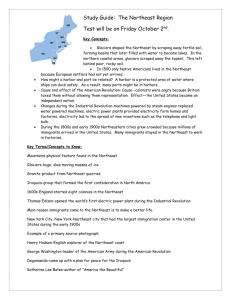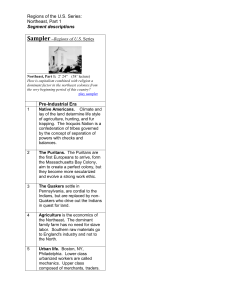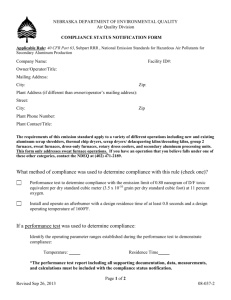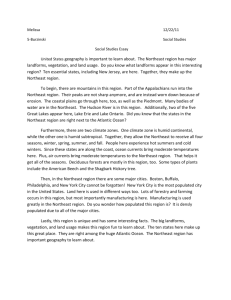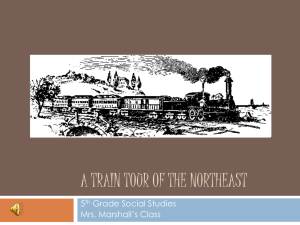Furnace Standards Memo from NEEP
advertisement
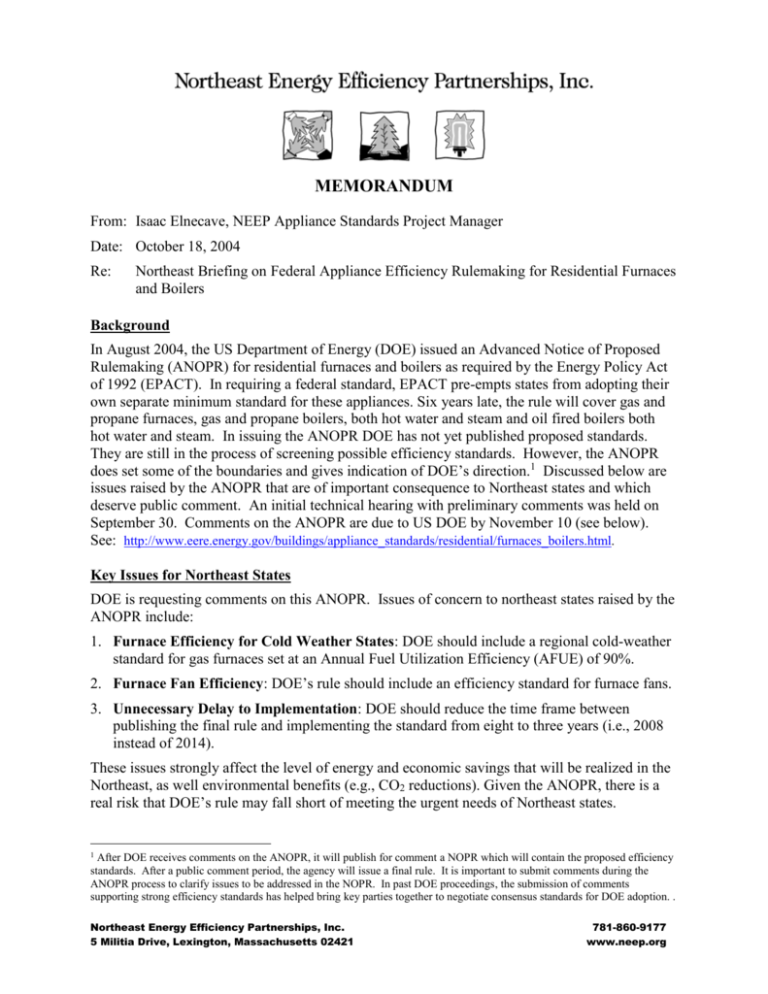
MEMORANDUM From: Isaac Elnecave, NEEP Appliance Standards Project Manager Date: October 18, 2004 Re: Northeast Briefing on Federal Appliance Efficiency Rulemaking for Residential Furnaces and Boilers Background In August 2004, the US Department of Energy (DOE) issued an Advanced Notice of Proposed Rulemaking (ANOPR) for residential furnaces and boilers as required by the Energy Policy Act of 1992 (EPACT). In requiring a federal standard, EPACT pre-empts states from adopting their own separate minimum standard for these appliances. Six years late, the rule will cover gas and propane furnaces, gas and propane boilers, both hot water and steam and oil fired boilers both hot water and steam. In issuing the ANOPR DOE has not yet published proposed standards. They are still in the process of screening possible efficiency standards. However, the ANOPR does set some of the boundaries and gives indication of DOE’s direction.1 Discussed below are issues raised by the ANOPR that are of important consequence to Northeast states and which deserve public comment. An initial technical hearing with preliminary comments was held on September 30. Comments on the ANOPR are due to US DOE by November 10 (see below). See: http://www.eere.energy.gov/buildings/appliance_standards/residential/furnaces_boilers.html. Key Issues for Northeast States DOE is requesting comments on this ANOPR. Issues of concern to northeast states raised by the ANOPR include: 1. Furnace Efficiency for Cold Weather States: DOE should include a regional cold-weather standard for gas furnaces set at an Annual Fuel Utilization Efficiency (AFUE) of 90%. 2. Furnace Fan Efficiency: DOE’s rule should include an efficiency standard for furnace fans. 3. Unnecessary Delay to Implementation: DOE should reduce the time frame between publishing the final rule and implementing the standard from eight to three years (i.e., 2008 instead of 2014). These issues strongly affect the level of energy and economic savings that will be realized in the Northeast, as well environmental benefits (e.g., CO2 reductions). Given the ANOPR, there is a real risk that DOE’s rule may fall short of meeting the urgent needs of Northeast states. 1 After DOE receives comments on the ANOPR, it will publish for comment a NOPR which will contain the proposed efficiency standards. After a public comment period, the agency will issue a final rule. It is important to submit comments during the ANOPR process to clarify issues to be addressed in the NOPR. In past DOE proceedings, the submission of comments supporting strong efficiency standards has helped bring key parties together to negotiate consensus standards for DOE adoption. . Northeast Energy Efficiency Partnerships, Inc. 5 Militia Drive, Lexington, Massachusetts 02421 781-860-9177 www.neep.org Federal Appliance Efficiency Rulemaking for Residential Furnaces and Boilers NEEP Briefing Memo – 10/18/04 Page 2 of 6 Need for a Regional Furnace Standard DOE’s ANOPR does not propose a particular set of efficiency standards, but it does indicate that the agency will propose one nationwide standard for each covered technology. The agency reasons that the intent of the enabling legislation, EPACT, was to establish one consistent standard for the country. Setting a regional standard would violate that principle. Unfortunately, this position will lead to an efficiency standard that does not meet Northeast needs as cost considerations in warm weather states will drive the agency to adopt a weak furnace efficiency standard (e.g., 80% AFUE). Colder weather in the Northeast (and Midwest), justifies a higher furnace efficiency standard2 for these regions (a cold-weather state is defined as a state with more than 5,000 average heating degree days). In fact, a significant percentage of gas furnaces sold today in the Northeast meet the 90% AFUE standard. A stronger regional standard for cold-weather states would provide significant additional energy savings over and above energy savings gained from simply raising the efficiency standards nationwide. In the Northeast, this would cover every state north of Maryland. For example, nationwide energy savings from simply raising the furnace efficiency standard to 81% AFUE would equal about 60 trillion BTUs. On the other hand, setting a coldweather region standard to 90% AFUE would mean an additional 90 trillion BTUs in energy savings. Because furnace use is significantly higher in cold-weather states, the higher efficiency standard is cost-effective and has a simple payback period of only 6 years. During the administrative hearings in September, manufacturers and industry representatives argued that a gas furnace standard should not exceed an AFUE of 80%. With Northeast states already facing some of the highest natural gas and electricity prices in the nation, this position would hurt consumers and residents in the region. We recommend that stakeholders in Northeast states recommend that DOE establish the following standards: Table 1: Federal Residential Furnace and Boiler Standards Product Type Gas & propane furnaces 78% AFUE Oil furnaces Gas & propane hot water boilers Oil-fired hot water boilers 78% AFUE Standard to Recommend to DOE 81% AFUE 90% AFUE for cold weather states 84% AFUE 80% AFUE 84% AFUE 80% AFUE 86% AFUE Gas & propane steam boilers 75% AFUE 82% AFUE Oil-fired steam boilers 80% AFUE 84% AFUE None 6.8%* Furnace Fan Current Federal Standard 2 A regional standard for boilers is unnecessary as the recommended national standard in Table 1 is sufficient for Northeast states and represents the large majority of boilers sold in the region today. A higher standard would require a condensing boiler which entails further installation expense and may not be applicable or cost-effective in all existing structures. Northeast Energy Efficiency Partnerships, Inc. 5 Militia Drive, Lexington, Massachusetts 02421 781-860-9177 www.neep.org Federal Appliance Efficiency Rulemaking for Residential Furnaces and Boilers NEEP Briefing Memo – 10/18/04 Page 3 of 6 Establish an Efficiency Standard for Furnace Fans: The DOE indicates in the ANOPR that it will not include in its rule an efficiency standard for furnace fans. DOE’s reasons that the enabling legislation allows the agency to set only one efficiency standard for furnaces, and that the legislation specifically states the use of AFUE as that standard. DOE contends that for the agency to establish a standard for furnace fans, the enabling legislation would have to be amended to specifically cover furnace fans. Furnace fans are one of the largest users of electricity in the home consuming approximately 1,000 kWh per year. Strong furnace fan efficiency standards could save between 500 and 800 kHz/year3. It represents one of the largest potentials for electricity savings in household appliances. By setting a standard that reduces energy use by about 60 percent, electricity consumption in the Northeast could be reduced significantly4. This is vital in a region beset by high electricity costs. Table 2 outlines the energy savings potential based on analyses by the American Council for an Energy Efficient Economy. Table 2: Annual Energy Savings in Northeast States Gained by Implementing a Furnace Fan Standard beginning in 2011 State New York Pennsylvania New Jersey Maryland Massachusetts Connecticut Maine New Hampshire Delaware Rhode Island Vermont Total Annual Energy Savings by 2030 (Gigawatt-hours) Gained by Furnace Fan Efficiency Standard Beginning in 2012 1,709 1,164 714 563 360 184 92 81 79 58 49 5,056 GWh We recommend that stakeholders in Northeast states ask DOE to establish a federal furnace standard at 6.8%. 5 3 Furnace fans circulate warm air as well as cool air in homes with central air conditioning (AC) systems. The higher range of savings represents the additional impact of high efficiency furnace fans in homes with central AC. See p. 22 of “Powerful Priorities, Updating Energy Efficiency Standards for Residential Furnaces, Commercial Air Conditioners and Distribution Transformers.” Appliance Standards Awareness Project, September, 2004. 4 Ibid, Table A-1. 5 The proposed furnace fan standard is expressed as a percentage of total annual furnace gas (or oil) and electricity use (with electricity use calculated on a primary basis) that is attributable to furnace electricity use – which is primarily the furnace fan. Today’s typical product uses 9.2% of total energy consumption of the appliance, while a typical product meeting this standard uses 4%. Alternative levels to 6.8% are appropriate for very large and very small equipment. Northeast Energy Efficiency Partnerships, Inc. 5 Militia Drive, Lexington, Massachusetts 02421 781-860-9177 www.neep.org Federal Appliance Efficiency Rulemaking for Residential Furnaces and Boilers NEEP Briefing Memo – 10/18/04 Page 4 of 6 Although it is preferable for DOE to address this as part of the federal furnace standard, DOE’s interpretation leaves open the option for individual states to achieve these significant savings by establishing state-based standards. Adopt New Standard Soon – Within 3 Years of Final Standard According to the ANOPR, any new efficiency standards would become implemented 8 years after the final rule is published. Under the best circumstances this implies that the Northeast would wait until 2014 for a new standard. Given that the federal standard is already six years behind schedule and that high efficiency furnaces and boilers already represent the majority of equipment sales in several Northeast states today, there is no reason to delay the implementation for another eight years. DOE should specify a time frame of three years between publishing the final rule and implementing the standard. Reasons for Including More Stringent Federal Standards: The recent sharp increases in crude oil prices will have an unwelcome direct and indirect effect on fuel prices this winter. Already suffering from some of the highest energy costs in the country, Northeast residents can expect to pay more for heating costs for the foreseeable future. According to the Energy Information Agency, heating oil users will pay 28% more and natural gas users will pay 15% more in heating costs this winter on average.6 Indirectly, the higher price for natural gas will certainly affect the cost of electricity due to the large number of power plants that now run on natural gas. The efficiency increases in residential furnaces and boilers are an important step in reducing energy costs for Northeast consumers, and gas and electric ratepayer funded programs have helped to make high efficiency furnaces and boilers the majority of appliance sales in several states. High Electricity Costs in Northeast States The Northeast suffers from the highest electricity prices in the country. The following table summarizes the prices Northeast consumers have to pay. Table 3: 2002 Retail Prices of Electricity for Northeast States State Maine New York Vermont New Hampshire Massachusetts Connecticut New Jersey Rhode Island Pennsylvania Delaware 6 Average Retail Electric Prices 11.4 cents/kwh 11.3 cents/kwh 10.9 cents/kwh 10.5 cents/kwh 10.2 cents/kwh 9.7 cents/kwh 9.3 cents/kwh 9.2 cents/kwh 8.0 cents/kwh 7.1 cents/kwh National Rank (Highest to Lowest) 3 4 5 6 8 9 10 11 13 17 “Winter Heating Costs Expected to Top $1,000 on Average” Boston Globe, October 7, 2004 Northeast Energy Efficiency Partnerships, Inc. 5 Militia Drive, Lexington, Massachusetts 02421 781-860-9177 www.neep.org Federal Appliance Efficiency Rulemaking for Residential Furnaces and Boilers NEEP Briefing Memo – 10/18/04 State Maryland Average Retail Electric Prices 6.2 cents/kwh Page 5 of 6 National Rank (Highest to Lowest) 31 Source: Department of Energy, Energy Information Agency, State Energy Profiles, 2002 High Natural Gas Prices: The Northeast also suffers from the highest natural gas prices in the country. The following shows how residential natural gas prices7 compare between Northeast states and the national average. The average price of natural gas sold to residential consumers nationwide is $10.03 per thousand cubic feet. The average price in the Northeast ranges from a low of $10.37 per thousand cubic feet in Vermont to a high of $13.64 per thousand cubic feet in Maine. The average price of natural gas sold to commercial consumers nationwide is $8.87 per thousand cubic feet. The average price in the Northeast ranges from a low of $8.27 per thousand cubic feet in Vermont to a high of $12.47per thousand cubic feet in Maine. The high cost of natural gas also affects electricity prices as more power plants in the Northeast start using natural gas as the primary fuel. The average price of natural gas sold to electric power consumers nationwide is $5.83 per thousand cubic feet. The average price in the Northeast ranges from a low of $6.62 in New York to a high of $7.62 per thousand cubic feet in Connecticut. Energy Efficiency Programs Have Established High Efficiency Heating Equipment as Standard Practice in the Northeast Given these high energy costs, utility commissions in several states - Massachusetts, Rhode Island, New Hampshire and New Jersey – have approved ratepayer-funded programs that offer incentives for high efficiency gas furnaces at two levels at 90% AFUE (ENERGY STAR specification) and at 92% AFUE including requirements for high efficiency furnace fans. In Massachusetts, Connecticut and Vermont, electric utilities offer incentives for high efficiency furnace fans for all systems. These programs have already had a substantial impact on the number of high efficiency furnaces sold in the Northeast. By 2000, the percentage of high efficiency furnace sales in Massachusetts, Connecticut, Maine and New Hampshire exceeded 50%, making high efficiency equipment a “standard practice.” These programs have helped to build the market conditions that support a more stringent minimum equipment efficiency standard today. Furnace standards at 90% AFUE will help to extend the cost savings benefits of this equipment to all consumers purchasing a boiler or furnace. Federal Furnace and Boilers Efficiency Standards Needed to Meet Climate Change Goals New England states and New Jersey have committed to climate change action plans that would reduce carbon dioxide emissions to 1990 levels or better by 2010. These states are looking to appliance efficiency standards as an important climate change action policy tool to achieve 7 The source for these three points is the Department of Energy, Energy Information Agency/ Natural Gas Monthly, August 2004. Northeast Energy Efficiency Partnerships, Inc. 5 Militia Drive, Lexington, Massachusetts 02421 781-860-9177 www.neep.org Federal Appliance Efficiency Rulemaking for Residential Furnaces and Boilers NEEP Briefing Memo – 10/18/04 Page 6 of 6 energy savings and the associated carbon dioxide reductions. Missing the opportunity to set a strong minimum efficiency standard for residential and furnaces and boilers by 2008 would be a set-back for climate change action plans in northeast states. Next Steps – Comments to DOE by November 10, 2004: Stakeholders can either write their own comments or submit them as part of a regional effort. NEEP, ASAP, ACEEE and the Alliance to Save Energy submitted preliminary comments for the administrative hearings that were held in September (they can be found at XXX). They provide a useful guide and more background information to help write the comments. NEEP is coordinating a regional effort to provide comments to DOE. In addition to encouraging individual letters, NEEP is drafting a common set of comments to DOE for multiple signature by utilities, state agencies, and environmental and/or consumer groups. Contact Isaac Elnecave for more information. The due date for comments on the ANOPR is November 10, 2004. Comments should be sent to Ms. Brenda Edwards-Jones U.S. Department of Energy Building Technologies Program Mailstop EE-2J ANOPR for Residential Furnaces and Boilers, EE-RM/STD-01-350 1000 Independence Ave. SW Washington D.C., 20585-0121 If you wish to send your comments electronically: furnacesboilers.anopr@ee.doe.gov For more detailed information please see the ASAP report referenced above which can be found at www.asapstandards.com. Also, contact Isaac Elnecave, Energy Efficiency Standards Project Manager at NEEP; 781-860-9177 ext. 23 or ielnecave@neep.org. Northeast Energy Efficiency Partnerships, Inc. 5 Militia Drive, Lexington, Massachusetts 02421 781-860-9177 www.neep.org

